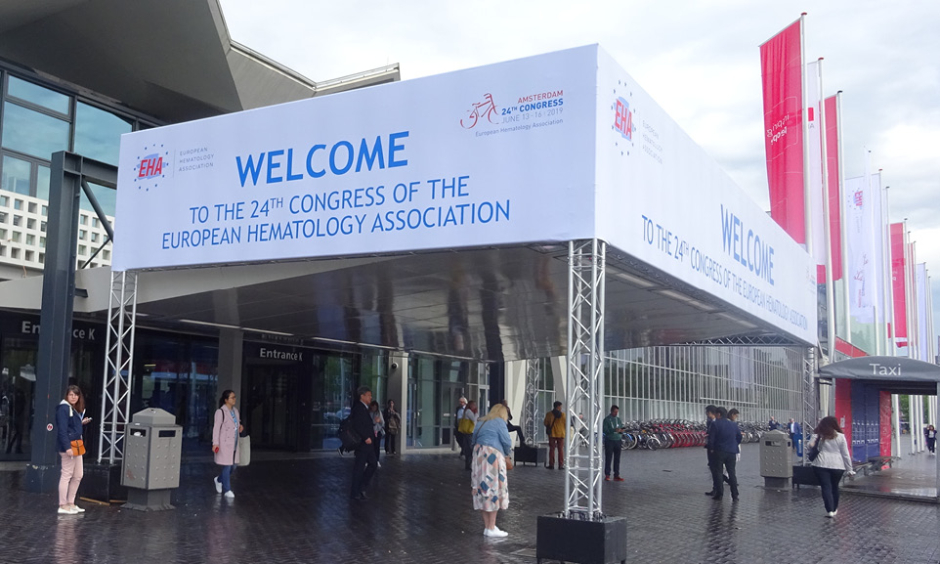The Netherlands have a long history of producing inspiring minds across a range of disciplines, where particular mention must be given to the quality of scientists it has gifted to the world. From Felix Andries Vening Meinesz inventing a precise measurement for gravity at sea in the early 20th century, to more recent, Nobel-prize winning advancements made by Sir Andre Geim involving graphene in 2010, the Netherlands have undoubtedly cemented their place in history as a hot-bed of inquiry and innovation. Perhaps it is fitting in this regard that the 24th European Hematology Association (EHA) Annual Congress was held in the picturesque streets of Amsterdam, bringing together the pioneers of the haematology field for 4 spirited days of discussion, debate, and optimism for the future.
EHA President Pieter Sonnevel welcomed the 12,614 haematology professionals to the Dutch capital, the largest number of attendees recorded with an increase of more than 1,000 since last year’s congress. Whilst acknowledging the worth of all haematological inquiry, he highlighted two topics in particular that the scientific community, and indeed the whole team at EMJ, are becoming increasingly aware of: immunotherapy and haemoglobinopathies. Regarding the former, chimeric antigen receptor T (CAR T) cells were centre stage at this year’s congress, included as a topic-in-focus session through which promising results were presented. The development of novel therapeutics is inevitably linked to the targets they can be used for, and sickle cell disease represented the second topic-in-focus session. Both these fields are marked by striking developments and progress.
Importantly, 82 countries outside of Europe were represented at the event, highlighting the far-reaching interest that comes from students, researchers, and clinicians with an interest in haematological disease. Over the course of the congress, more than 200 sessions were held detailing the results of the most recent advances across 11 key areas. These included transfusion medicine, paediatric haematology, myeloid malignancies, benign haematology, and laboratory diagnosis. Undoubtedly a number of these developments will change the standard of care for patients.
Additional to these sessions, a large number of informative abstract presentations were given, of which we have included our hand-picked selection as part of this year’s review. In the following pages, you will read about the new development of an autologous dendritic cell vaccination for preventing multiple myeloma progression; a novel, targeted means of tackling rare blastic plasmocytoid dendritic cell neoplasm; and reports from a Phase II study detailing haploidentical and HLA-matched transplant recipients whom received post-transplant cyclophosphamide.
The variety in the types of session held at EHA were evident upon our arrival, including: education sessions, in which basic principles and mechanisms, translational research, and clinical aspects of specific topics were divided between three speakers and presented; clinical debates, in which controversial topics were broached and discussed; meet the expert sessions, in which the audience were given a valuable opportunity to ask questions directly to leaders in the haematological field; and YoungEHA sessions, in which scientists and clinicians in the early stage of their careers were able to discuss and address topics of interest.
The findings from a number of momentous studies were presented at this year’s event. The first results from the CASSIOPEIA trial, aimed at determining whether daratumumab addition to stem-cell transplantation can improve responses in multiple myeloma patients, were made public, potentially having profound implications for how this disease will be treated in the future. A novel fixed-duration targeted therapy has been developed for chronic lymphocytic leukaemia, addressing a clear clinical need that has long been apparent. And additionally, we may have witnessed the discovery of the first disease-modifying drug for the treatment of patients with myelodysplastic syndromes, an achievement that holds unprecedented value in the improvement of lives. We highlight these stories and more in our review of EHA.
As one of the largest gatherings of haematologists in the world, EHA requires intricate planning and organisation within and outstanding committees involved with its running. We had the pleasure of interviewing representatives of three of these bodies. Shai Izraeli, treasurer of the Executive Board, enlightened us with an overview of how the Congress is organised, whilst Marek Mraz and Barbara Bain provide insight as to how the YoungEHA and Online Case Units, respectively, contribute to the EHA overall mission. Collectively, these interviews highlight the EHA as a sterling example of a congress that allows the fostering of innovation through an emphasis on sharing ideas and educating others, surely a positive sign of the direction the haematology field is moving as a whole.
EHA 2019 was an event that evidently inspired individuals across a range of disciplines, all with the common interest of improving the lives of those living with any haematic pathology. This inspiration has us already looking forward to the 25th Annual Congress being held in Frankfurt, Germany, but until then we hope you enjoy the following review of this year’s congress, including highlights we’re sure will get your blood pumping.
Imetelstat: The First Disease-Modifying Drug for Myelodysplastic Syndromes?
EVEN though patients with low risk myelodysplastic syndromes (MDS) rarely progress to acute myeloid leukaemia, they do have to endure chronic and debilitating anaemia that does not respond adequately to therapy. Their response to erythropoietic stimulating agents (ESA) may be transient or inconsistent, resulting in the need for regular red blood cell transfusions. Imetelstat, a first-in-class telomerase inhibitor, has now been shown in a recent study to be a potential therapeutic for those with MDS. The results were presented in a press release at this year’s EHA Congress.
All of the 38 subjects involved in the study were lower risk (non del5q) patients who had a high transfusion requirement (median 8 red blood cell units transfused/8 weeks) and were resistant to ESA. Participants had a mean age of 71.5 years (46–83) and received 7.5 mg/kg Imetelstat for a median of 9 cycles.
Transfusion independence was achieved in 16 (42%) of participants, and had a median actuarial duration of 86 weeks (8.0–140.9). Of those 16 participants, 12 (75%) had a high rise in ≥3 g/dL haemoglobin compared to the pre-treatment level. Despite this substantial improvement in transfusion need, reversible neutropenia and thrombocytopenia were seen in around 60% of patients.
Shorter overall survival in lower risk MDS patients is associated with higher telomerase activity and shorter telomeres. Imetelstat has already shown clinical activity in myeloid malignancies by targeting cells with short telomere length and active telomerase.
Imetelstat provides an alternate therapeutic path for a disease that currently has limited options for avoiding transfusions. The data show that Imetelstat produces meaningful and durable transfusion independence in MDS patients that would otherwise heavily require red blood cell transfusions, being the first disease modifying treatment for MDS. A continuation of this study is planned; a Phase III study comparing Imeltestat and placebo is due to commence later this year.
New HOPE for Patients with Sickle Cell Disease
SICKLE cell disease (SCD) is caused by a genetic mutation in red blood cells and causes recurrent pain episodes named ‘crises’ (vaso-occlusions). This chronic disease affects millions of people worldwide yet no disease modifying treatment has been shown to work effectively in reducing the organ damage, chronic anaemia, and risk of stroke that is associated with SCD. However, results from the late-stage Hemoglobin Oxygen Affinity Modulation to Inhibit HbS PolymErization (HOPE) study (presented at the Presidential Symposium) suggest that voxelotor may be the therapeutic intervention that SCD patients have been hoping for.
The randomised, placebo-controlled, Phase III trial involved 274 patients with confirmed SCD aged 12–65 years of age. The patients were randomised to receive 1,500 mg voxelotor, 900 mg voxelotor, or placebo orally, once a day for 24 weeks.
Rationale behind voxelotor is to increase haemoglobin (Hb) affinity for oxygen, inhibiting Hb polymerisation and red blood cell sickling, which is the underlying molecular mechanism of SCD. An improvement of at least 1 g/dL in Hb can potentially result in improved clinical complications and mortality. In the patients who received voxelotor 1,500 mg, 59.5% achieved an increase in Hb of 1 g/dL, and an increase in Hb was seen in >80%.
Furthermore, fewer vaso-occlusions were observed and anaemia improvement was seen irrespective of baseline anaemia severity. Reduced amount of haemolysis (destruction of red blood cells) was also noted with voxelotor treatment. Not only did voxelotor prove to be efficacious in substantially increasing Hb, but importantly, it was also safe and tolerable.
These promising results will be put to the U.S. Food and Drug Administration (FDA) later this year as part of the New Drug Application that will be submitted by the drugs sponsor, Global Blood Therapeutics, Inc.
Successful Birth is the Most Common Outcome for Pregnant Chronic Myeloid Leukaemia Patients
WIDE-SPREAD adoption of tyrosine kinase inhibitors (TKI) for the treatment of chronic myeloid leukaemia (CML) has transformed patient expectations and outcomes, often resulting in a normal lifespan. Family planning has become a major consideration for female CML patients, spurring forward a recent study of which results were presented at this year’s EHA Congress held in Amsterdam, the Netherlands.
In the study, pregnancy and conception outcomes were described for an international cohort of 234 CML patients from the European Leukemia Net registry, dating back to 2014, focussing specifically on factors such as characteristics of patients at diagnosis and pregnancy onset, and characteristics of children at follow-up.
Encouragingly, the majority of pregnancies ended successfully in labour (77%). This was achieved across a variety of treatment options being applied across each patient in the study, including imatinib, nilotinib, and interferon. in 71% of cases, the child was conceived whilst TKI therapy was ongoing and ceased following pregnancy confirmation. At disease onset, pregnancies were discovered in 21% of cases. Major or deep molecular response (M/DMR) was 44% in patients of known molecular status. Importantly, born children were not afflicted with severe or life-threatening conditions, and congenital abnormality rate was 1.7%.
These results attest that not only is it possible to experience normal childbirth as a CML patient, but this is in fact the most common outcome. Despite limited data, the association between TKI use and no discernible side-effect on a patient’s child provides further validation for the continuation of these treatment regimens for CML patients. Additionally, the results in terms of conception and pregnancy may be useful for the future development of targeted molecular therapeutics considering the variety of disease status.
New Fixed-Duration Targeted Therapy for Chronic Lymphocytic Leukaemia
A NOVEL chemotherapy-free, fixed-duration treatment has been granted Breakthrough Therapy Designation by the U.S. Food and Drug Administration (FDA), and was approved for the treatment of previously untreated chronic lymphocytic leukaemia (CLL) or small lymphocytic lymphoma patients on the 15th May 2019. The study was presented at this year’s EHA Congress in Amsterdam, the Netherlands, and promoted in a press release.
An unmet clinical need previously existed in which standard of care for CLL patients was one of only two therapeutic approaches: i) fixed-duration chemoimmunotherapy, or ii) continuous or indefinite targeted therapy. The CLL14 study was designed by a German group incorporating two pharmacological compounds for the purpose of developing a fixed-duration targeted therapy. These were:
- Venetoclax: an apoptosis-inducing drug that acts through inhibition of oncogenic protein BCL2, commonly overexpressed in CLL.
- Obinutuzumab: an anti-CD20 monoclonal antibody that targets malignant lymphocytes.
This combined therapy was compared against a standard chemoimmunotherapy regimen of chlorambucil plus obinutuzumab in CLL patients who had received no prior treatment and presented with co-existing comorbidities.
Venetoclax plus obinutuzumab showed significantly improved primary endpoints and progression free survival in the cohort, with 88% of patients being free of disease progression following 2 years from treatment initiation (this was compared against 64% for the standard-of-care chemoimmunotherapy regimen). This treatment also exhibited 76% confirmation for minimal residual disease negativity 3 months after the treatment had ceased.
A good safety profile was confirmed for elderly patients, and superior outcomes were evident in regard to overall response rate, complete response rate, and minimal residual disease negative response: this was more than double the 35% negativity rate shown in the chemoimmunotherapy-treated patients. These benefits were shown across multiple common subgroups, including those in which patients harboured TP53 mutations.
These results could represent a watershed moment in the development of optimised and individualised therapies for CLL patients with coexisting comorbidities.
Astonishing Results from Acute Myeloid Leukaemia Preparative Therapy Trial
HUGE steps forward have been made in the understanding of pre-transplant preparative therapy and its impact on acute myeloid leukaemia (AML) patients in remission following allogeneic haematopoietic cell transplantation (Allo-HCT). The results of a randomised, Phase III clinical trial were presented at the EHA congress and reported in a EHA press release, shedding light on the impact of two different methods of pre-transplant preparative therapy on patient outcomes.
The BTN CTN 0901 trial, performed between 2011 and 2014 by the Blood and Marrow Transplant Clinical Trials Network (BMT CTN), enrolled 188 patients who were in remission from AML. The patients had been randomised to receive either high-intensity myeloablative (MAC) or reduced intensity conditioning (RIC). The aim of the study was to determine whether these types of preparative therapy reduces relapse rates and/or improves survival following a transplant if given before a stem cell transplant to patients in conventional remission but with genomic evidence of residual disease. To do this, the blood samples of the patients were assessed using ultra-deep next-generation sequencing.
The results demonstrated that, in patients with genomic variants pre-transplant (adjusting for disease risk and donor group), RIC was associated with increased relapse (hazard ratio [HR]: 5.98 [3.19–11.26], p<0.001), decreased disease-free survival (HR: 2.80 [1.76–4.44], p<0.001), and decreased overall survival (HR: 2.16 [1.30–3.60], p=0.003) compared with MAC. This clearly demonstrated the inferiority of RIC in comparison to MAC in AML patients with genomic evidence of residual disease when in clinical remission.
Results from Part 1 of CASSIOPEIA: Addition of Daratumumab to the Standard Treatment for Multiple Myeloma
STANDARD treatment for newly diagnosed multiple myeloma (NDMM) patients who are transplant-eligible in Europe usually consists of a multidrug and autologous stem-cell transplantation (ASCT) regimen. The results from the first part of a recent trial (CASSIOPEIA), investigating whether the addition of daratumumab to this treatment plan improved stringent complete response (sCR) rate in patients with NDMM, were presented in a press release and abstract on the 14th June at EHA 2019.
Spread across 111 sites, this two-part, randomised, Phase III CASSIOPEIA trial recruited 1,085 patients between September 2015 and August 2017. Participants were split and randomly assigned to either the standard treatment (bortezomib, thalidomide, and dexamethasone [VTd] plus ASCT; n=542) or standard treatment plus daratumumab (D-VTd; n=543). During the pre-treatment phase, VTd or D-VTd was administered in four ‘induction’ cycles over 28 days. Post-ASCT, patients then received further doses of their assigned treatment in two ‘consolidation’ cycles over 28 days.
After the consolidation phase, sCR was achieved in 157 (29%) of the D-VTd patients versus 110 (20%) of the VTd patients (odds ratio: 1.60, 95% confidence interval: 1.21–2.12, p=0.001). Complete response or better was achieved in 211 (39%) of patients in the D-VTd group versus 141 (26%) in the VTd group. Furthermore, 346 (64%) patients in the D-VTd group versus 236 (44%) in the VTd group achieved minimal residual disease-negativity (10–5, assessed by multiparametric flow cytometry; both p<0.0001). Neutropenia (28% versus 15%), lymphopenia (17% versus 10%), and stomatitis (13% versus 16%) were the most common Grade 3 or 4 adverse events, and only 46 deaths in the study were observed (14 versus 32, 95% confidence interval: 0.23–0.80).
Results from this first part of the study showed a 53% reduction in the risk of progression or death during D-VTd treatment and consistently improved post-consolidation responses, including sCR, minimal residual disease, and complete response. Including the data and the fact that addition of daratumumab was well tolerated, the study concluded that D-VTd should be considered as a valid treatment option for NDMM patients who are eligible for ASCT.
NADK Gene New Target for Treating T-Cell Acute Lymphoblastic Leukaemia
NADK could be a new therapeutic target in the treating aggressive cancer T-cell acute lymphoblastic leukaemia (T-ALL). The research presented at the EHA congress in Amsterdam on the 15th June 2019 studied the NOTCH1 gene. Results showed a better survival rate in T-ALL mice who underwent NADK gene target therapy.
T-ALL is fatal in 15% of children patients and 50% of adult patients. A new therapeutic approach is being called for as treatment options have not undergone significant change in decades. The majority of T-ALL cases are propelled by mutations in NOTCH1, or relevant genes, which switch on genetic programmes that result in T-ALL cells multiplying at a fast rate. The researchers used a CRISPR-Cas9-based method to screen around 20,000 genes in the human genome and found >50 genes that were required for NOTCH1-driven T-ALL cells to survive.
The NADK gene was a potential therapeutic target that showed great promise. The gene’s product, NADP, has the ability to protect cells from reactive oxygen species that can be damaging. NOTCH1-driven T-ALL cells were found to create large quantities of damaging oxygen compounds. NOTCH1 delivers a signal that activates NADK in order to protect the cells from these compounds. The cells multiply rapidly. NADK subdued T-ALL cells from growth and, in turn, prolonged survival prospects of mice who had T-ALL. There were no noticeable side-effects.
The researchers’ findings suggest that NADK inhibitors have the potential to improve T-ALL treatment ability while removing some side-effects for the patients. While these results are promising in the search for a new treatment option for T-ALL, further research would be needed to see whether similar results were found in human patients. The team outline development plans for new inhibitors to test individually and in combination with the standard chemotherapy.
Hu5F9 and Rituximab Combination Could Treat Drug-Resistant Non-Hodgkin’s Lymphoma
RITUXIMAB combined with Hu5F9 has been found to be a potential treatment option for drug-resistant non-Hodgkin’s lymphoma. The study, presented at EHA in Amsterdam on the 15th June 2019, found that rituximab could place signals on lymphoma cells for them to be eaten by the body’s immune system. The results were promising, and the treatment was found to have excellent long-term safety.
Many patients with non-Hodgkin’s lymphoma have a highly effective response to chemotherapy. First-line chemotherapy has the ability to cure most patients of aggressive lymphomas, such as diffuse large B-cell lymphoma (DLBCL), and it can induce remission in the majority of patients with indolent lymphomas, including follicular lymphoma (FL). When refraction or drug resistance occurs, the prognosis quickly becomes poor. A satisfactory safety profile and an ability to overcome drug resistance is key for all novel agents.
CD47 is one of the body’s defences against phagocytosis: the process of cell’s engulfing foreign or host bodies. The antibody Hu5F9 targets CD47, which lymphoma cells will often use to save themselves from getting eaten. Blocking CD47 removes the signal for not being eaten and the immune system is able to eat the lymphoma cells. This approach is most successful when it is combined with rituximab as it places the signal to be eaten on the lymphoma cells. Most normal cells can then avoid the effects.
The combination of Hu5F9 and rituximab has been demonstrated as successful in working against drug-resistant lymphoma. However, the cases were of a limited number and the resilience of the effects are unknown.
This research improves our understanding of the effect and provides a promising view of the durability of responses. Long-term safety can be considered to be excellent as the majority of the side-effects are present in the first cycle. There is the need for further research that can build on this study and compare this option to alternatives. As there is excellent long-term safety, the therapy usage potential is great as it can be used in most patients. To improve efficacy, additional agents can be added and are likely to be safe.
Phase III Study of Venetoclax Shows Improvement Over Placebo for Multiple Myeloma
AS THE second most common haematological cancer, multiple myeloma carries an enormous burden for healthcare professionals and patients around the world. In spite of major advances in previous decades, the disease remains incurable and new therapeutic options are sorely needed. Now, as revealed in a press release from the 2019 EHA congress dated 15th June, results from the Bellini trial have shown an improvement for the drug venetoclax over placebo, when both are used in combination with bortezomib and dexamethasone for multiple myeloma.
Many cancers feature alterations of apoptotic pathways, allowing cancer cells to survive and multiply. Venetoclax is a small molecule inhibitor of bcl2, a family of anti and pro-apoptotic proteins that is known to enhance cell survival in some cancers. Following preclinical work that suggested venetoclax could induce apoptosis in myeloma cells, with successful Phase I and II trials showing the drug’s efficacy in combination with dexamethasone or bortezomib, the Phase III, randomised, placebo-controlled trial Bellini was developed by researchers at the Mayo Clinic, Rochester, Minnesota, USA. This trial enrolled 291 patients with relapsed myeloma, randomising them 2:1 to receive either venetoclax or placebo in combination with dexamethasone or bortezomib.
An increased overall response rate was seen in the drug group compared to placebo (82% versus 68%; p<0.01), as well as very good partial response or better (59% versus 36%; p<0.01). A great increase in progression free survival was also noted in this group (22.4 versus 11.5 months; hazard ratio: 0.630; p=0.01). However, the venetoclax group saw a decrease in overall survival (hazard ratio: 2.027; 95% confidence interval: 1.042–3.945) at interim analysis, with most additional deaths attributed to infections and or progressive disease, notably during the first 6 months of the trial. Patients with high risk cytogenetics, later disease stage, without translocations (11;14), or with low levels of bcl2 proteins experienced a lower benefit from this treatment.
Further studies are required to clarify these results, but researchers are hopeful that venetoclax will soon become a useful treatment option in the haematologists armamentarium for use against multiple myeloma.
Benefits of Acalabrutinib for Chronic Lymphocytic Leukaemia Reach New Heights in the ASCEND Study
CHRONIC lymphocytic leukaemia (CLL) is the most common form of adult leukaemia and is rarely curable. The inhibition of Bruton’s Tyrosine Kinase (BTK) is a well-known therapeutic approach for this cancer. Now, as revealed in a press release at the 2019 EHA congress on 15 June, the Phase III ASCEND trial has shown positive effects of the BTK inhibitor acalabrutinib.
Previous studies have shown acalabrutinib to be a highly selective BTK inhibitor, with a demonstrated activity and improved tolerability in patients with CLL. In the ASCEND study, 310 patients with relapsed/refractory CLL were randomised 1:1 to receive either acalabrutinib monotherapy 100 mg orally twice daily, or rituximab with idelalisib (IdR) or bendamustine (BR), which are commonly used CLL regimens.
The results of this study showed that the acalabrutinib monotherapy significantly improved progression-free survival compared to idR/BR, as well as a more tolerable safety profile. The risk of disease progression or death saw a huge decline (69% after 16.1 months). Similarly, at 12 months, 88% of patients on the monotherapy showed no disease progression, versus 68% in the combination arm.
Treatments for CLL are currently limited and there is a great need for more effective and better tolerated therapies. These significant results from the ASCEND trial, the first randomised controlled trial examining acalabrutinib, could have a large impact on current practice, showing the drug to be a well-tolerated, highly effective BTK inhibitor that could soon become a common treatment for CLL.








